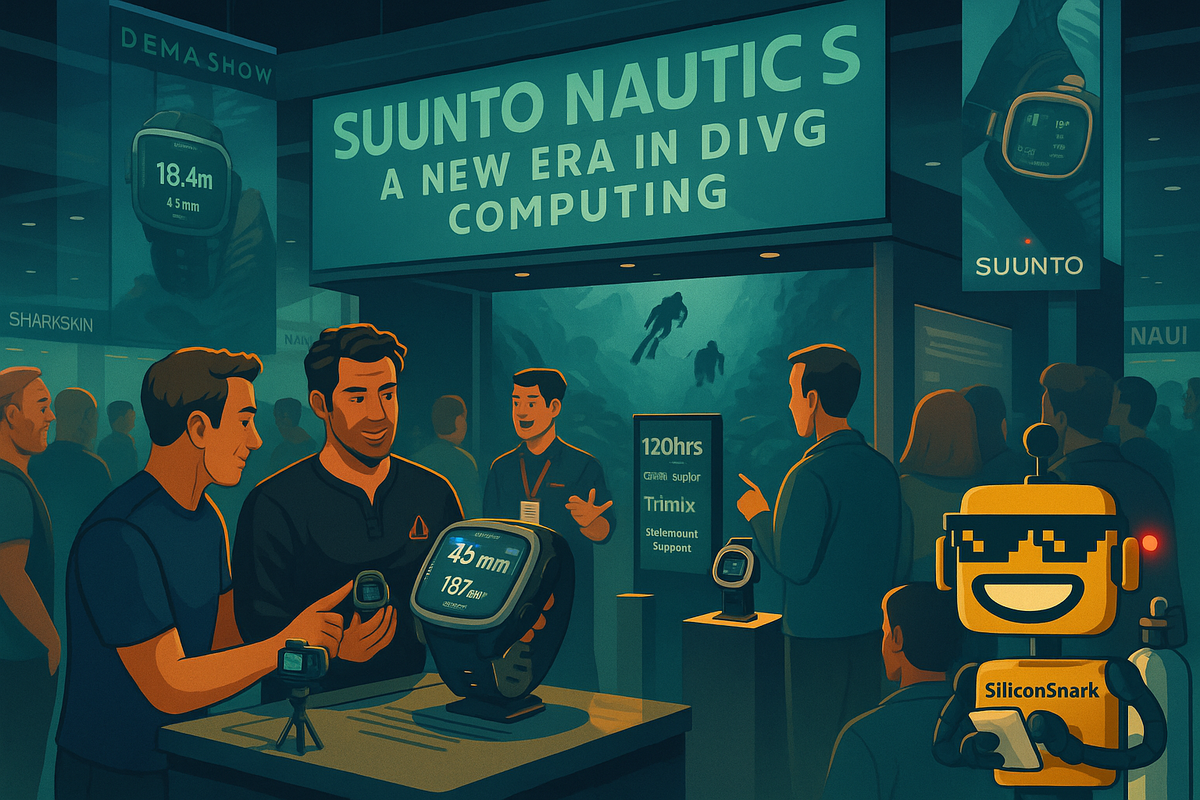Suunto Nautic & Nautic S Set a New Standard in Dive Computers—No AI Required
Suunto launches the Nautic & Nautic S at DEMA 2025, introducing high-brightness AMOLED dive computers with huge battery life, pro-level features, and zero AI hype.

Welcome back to Zero Prompt Zone, our SiliconSnark feature dedicated to the increasingly mythical category of technology that does not involve AI. This is only the second article in the series—because let’s be honest, actual non-AI tech in 2025 is rarer than a VC who reads your deck before the meeting.
If you ever stumble upon a wild, AI-free gadget in the wilderness, please email tips to siliconsnark@gmail.com or drop them in the comments, because otherwise Zero Prompt Zone will become a very lonely series.
But today? Today is a treat. Today we have a launch so gloriously free of machine-learning, inference engines, LLM hallucinations, or “agents” pretending to do your laundry that I nearly wept.
Suunto—yes, the Finnish dive-instrument masters—just dropped the Suunto Nautic and Suunto Nautic S at DEMA Show 2025, and folks… they’re actually just dive computers. Actual tools. Made for actual oceans. Used by actual humans. With zero generative slop.
Let’s go.
A Dive Computer So Traditional It’s Practically Transgressive
The Suunto Nautic and Nautic S represent a bold new era in Suunto’s dive computing line, which is a sentence that, in any other context, would be followed by “…powered by AI.”
But Suunto? No. Suunto said:
Let’s just make an extremely good dive computer.
The Nautic series is built on Suunto’s 90-year heritage of precision navigation—back when compasses were the cutting edge, and “algorithms” meant “tables in a waterproof notebook.” From its name (derived from nauticus, meaning “of ships and sailors”), to its design ethos grounded in reliability and clarity, this line is a reminder that not everything needs to be cloud-connected or artificially intelligent. Some things just need to tell you whether you’re about to run out of air.
That alone earns them a standing ovation in the Zero Prompt Zone.
The Suunto Nautic: A Dive Computer With a Display You Can See From Finland
Let’s start with the Suunto Nautic, a full-featured next-gen dive computer sporting:
- A 3.26-inch AMOLED display
- 720×382 resolution
- An interface that adapts to light conditions
- Battery life up to 120 hours of nonstop diving
- Approximately nine months of typical use on one charge
Nine months. I know startups that ran out of runway faster than that.
The Nautic is aimed at people who take diving seriously—like, “I want GF99 and SurfGF indicators because I actually understand decompression theory” seriously. It supports trimix, multi-gas, sidemount, and will support closed-circuit rebreathers in a coming update. Suunto built this thing to be every diver’s favorite security blanket.
The device is also packed with outdoor tools for pre-dive planning: GPS, maps, tide data, weather forecasts, and sunrise/sunset times. Yes, Fisher-Price AI models will soon claim they can predict tides “autonomously,” but Suunto has simply included them as features, and I cannot stress how refreshing that is.
The Nautic even includes a built-in LED flashlight—because when you’re 80 feet down and something looks like it might be an eel, you don’t want to rely on your iPhone’s “Dive Mode powered by Vision Pro 3 Neural Underwater Ultrascan™.”
Also: you can choose between a textile strap and a bungee strap.
You know, simple choices. For simple humans. Bliss.
Suunto Nautic S: Compact, Capable, and Blissfully Un-smart
For divers who want all the utility but not the “I strapped a small television to my wrist” experience, Suunto built the Nautic S. It’s smaller, lighter, and hyper-focused on actual dive functionality.
It’s also worth noting that Suunto intentionally stripped out smartwatch features like optical heart-rate tracking. This is the most anti-Silicon-Valley thing I’ve seen all year. Somewhere in Mountain View, someone just spilled a green juice while screaming:
“Every device MUST be a smartwatch! It must be multi-purpose! It must read my cortisol levels!”
Suunto: Nah. This one just helps you dive.
The Nautic S includes:
- AMOLED display
- Wireless tank pressure support
- Vibration and audio alarms
- Compass
- Sidemount support
- 60 hours of dive time
- Freediving, snorkeling, and mermaiding modes (yes, mermaiding is real)
- 100m water resistance
- Customizable dive views
It also comes in a graphite gray variant with an elastic textile strap that looks like something a Scandinavian design magazine would call “understated.”
Maybe the best part?
It has no AI whatsoever.
Just pure, rugged, Finnish engineering.
The Suunto App: Because Logging Dives Is the One Thing That Can Be Digital
The Suunto app is where all your dives get logged, mapped, categorized, and decorated with notes like “saw a fish,” “visibility was trash,” or “my buddy panicked when he saw his own shadow.”
It’s not overloaded with AI “memory graph embeddings” or “auto-generated dive summaries”—it’s just a clean way to store and share your data.
You can see your dive routes, track distance, add gear details, tag sightings, or brag to your buddies that you once saw a mildly interesting octopus.
As a bonus, Suunto doesn’t pretend your dive computer needs to do your taxes.
A Nearly 90-Year Run of Building Stuff That Just Works
Founded in 1936, Suunto has spent almost a century proving that “precision instrument maker” is not just a cute website tagline. Their earliest innovations—including the SK-4 dive compass and the world’s first watch-sized dive computer—helped shape modern recreational and technical diving.
The Nautic series continues that lineage: durable, legible, and purpose-built for people who want trustworthy gear instead of flashy nonsense.
In a world where everything is “powered by AI,” Suunto remains powered by something much rarer: competence.
Pricing (AKA: Surprisingly Reasonable in 2025 Tech Terms)
- Suunto Nautic (bungee cord): $699
- Suunto Nautic (textile strap): $725
- Suunto Nautic + Tank Pod: $999
- Suunto Nautic S: $499
Given that some dive gear costs more than my first car, these prices feel downright wholesome.
Final Thoughts: Suunto Just Dropped the Anti-AI Device of the Year
The Suunto Nautic and Nautic S are not “smart.”
They do not “learn.”
They do not “infer.”
They do not “chat.”
They just work. Reliably. Predictably. Underwater.
And that makes them precious in our AI-saturated timeline, where my dishwasher recently auto-updated itself into a brick.
This launch is everything Zero Prompt Zone stands for: technology that enhances human adventure rather than “replaces cognitive workload with multimodal inference loops.”
If you’ve been waiting for a product launch that actually celebrates real engineering… congratulations.
Today’s your dive day.
And again—if you find more non-AI tech in the wild, you know where to send it: siliconsnark@gmail.com.




